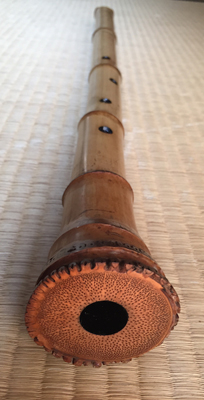The shakuhachi is a flute created in Edo Period Japan by Zen monks who called themselves komusō (虚無僧 - illusory nothing monks). Playing the shakuhachi was a primary form of meditation practice for the komusō. The shakuhachi evolved from the Chinese bamboo flute, imported to Japan to be used in Imperial Court music, and eventually modified by the komusō to be made from the strong and dense root end of bamboo rather than the weaker and thinner middle, making it possible to double as a weapon. The komusō formed the Fuke Sect of Zen Buddhism.
While the shakuhachi is a bamboo flute with only 5 holes, it is capable of an astonishing array of sounds and tones. Today a variety of music is played on the shakuhachi, from jazz and other modern music to Japanese folk songs. But the shakuhachi was created specifically to play one kind of music, honkyoku, the original Zen pieces composed as exercises for meditation, for begging for alms, and to express nature. The practice of playing honkyoku for meditation is today called suizen, "blowing Zen".
Playing honkyoku on the shakuhachi for the purpose of suizen or blowing meditation is similar to the practice of zazen or sitting meditation. Honkyoku music is written so that each phrase takes one full breath, and there are typically moments of silence between each breath or phrase. Attention is focused on the breath, the sound created by the breath, the silence between phrases, or with open awareness. When attention wanders it is returned to the breath, the sound, or to open awareness. Honkyoku can be beautiful to listen to, but really they are meant to be played.
The Sound
This is a recording of myself playing a piece, not a traditional honkyoku, composed and taught to me by Cornelius Boots on a 2.8 shakuhachi made by Kenji Ikegami:
And this is myself playing a honkyoku called Tamuke, a requiem, played on a 2.7 made by Jon Kypros:
Honkyoku Music
Although honkyoku music, like any music, is composed of phrases that are made up of a series of tones, it is not music in the traditional sense. There is no rhythm in honkyoku, only the flowing of the breath through the shakuhachi. Honkyoku music also lacks melody in the traditional sense. There are repeating phrases in many pieces, but the character is different. You can find out more on my honkyoku music page.
Suizen
Playing the shakuhachi for suizen or blowing meditation is different than playing for musical purposes. The shakuhachi is a versatile instrument that sounds beautiful and works very well for many types of music, but my primary interest is in the traditional context. For more, see my page on suizen.
Shakuhachi Gallery
If you'd like to see pictures of different shakuhachi, of various types and makers, see my Shakuhachi Gallery page.
Buying a Shakuhachi & Taking Lessons
The original shakuhachi was identical to what you see in the image at the top of this page, a once piece bamboo flute made from the root end of a piece of bamboo. The length of the flute varied, but the standard was around 54.5cm and in the key of D. The word shakuhachi refers to this length, what is known as a 1.8, or one shaku eight sun. Hachi is the word for eight in Japanese, thus shaku-hachi refers to one shaku and eight sun. However, the shakuhachi can be made both shorter and longer, and they are referred to by their size, a 1.6 shakuhachi, a 1.8 shakuhachi, a 2.0 shakuhachi, and so on. The shorter the flute, the higher the pitch. Here is a nice size and pitch chart. Although the standard 1.8 is the most common size to learn on, and most teachers will prefer you to have a 1.8 for lessons, my preference is for longer flutes. I find them easier to play and I prefer the lower/deeper tones.
Here is a 1.6 two piece flute of mine made by Kitahara II:

Today shakuhachi are most often made with a joint in the middle, as in the picture above, so they can be broken into two pieces. This makes them easier to transport, and they are easier for the maker to make due to having better access to the middle of the bore. However, the joint in the middle makes the flute more prone to crack with humidity and temperature changes, and is vulnerable to wearing out over time. My preference is for the original one-piece design.
There are shakuhachi makers in many countries around the world, not only in Japan, that make terrific flutes. Prices range from about $100 to many thousands of US dollars. While the shakuhachi looks like a very simple instrument, and in some regards it is, making one that is able to play honkyoku music properly is a skill that takes a great deal of knowledge, dedication, and time. A high quality traditional root end shakuhachi will cost well over $1,000 both in and outside of Japan. For places to buy a shakuhachi, see my shakuhachi resources page.
My primary shakuhachi teacher is Jon Kypros, who offers lessons worldwide via Skype. I highly recommend him as a teacher. I have also studied with Yodo Kurahashi in Kyoto, and Cornelius Boots.
Shakuhachi Resources
The shakuhachi is not a well known instrument in the west, and unfortunately there aren't that many websites that cover it in English. But there are several good ones. For links to shakuhachi makers, informative websites, papers, and more, see my Shakuhachi Resources page.


